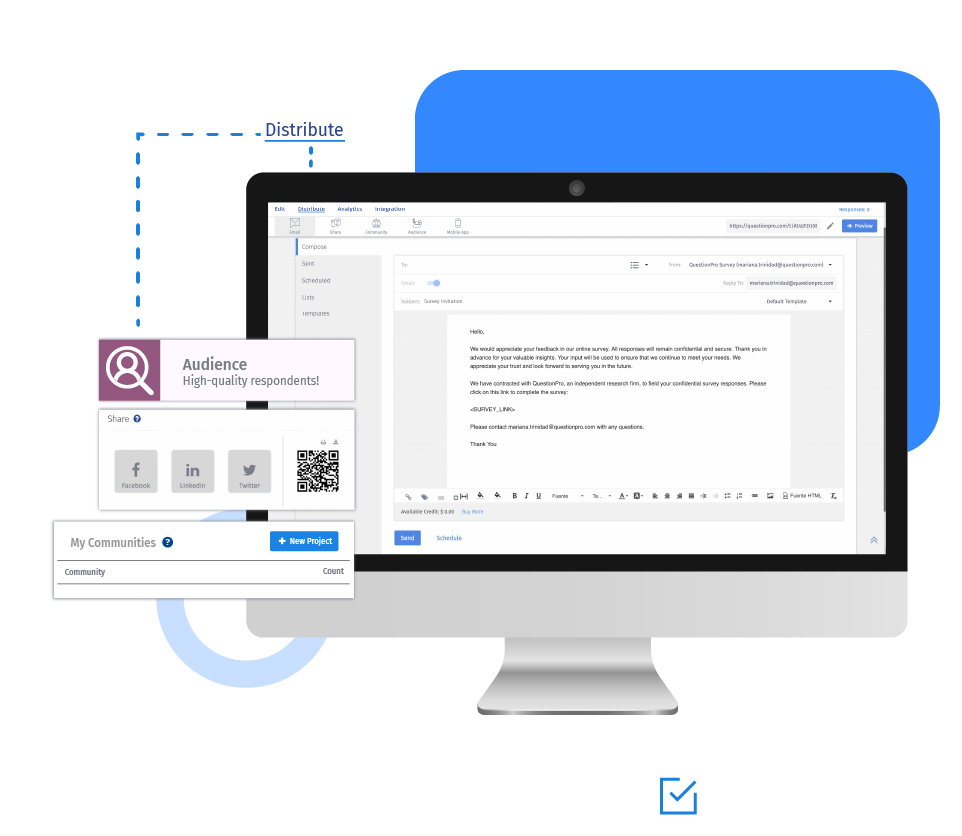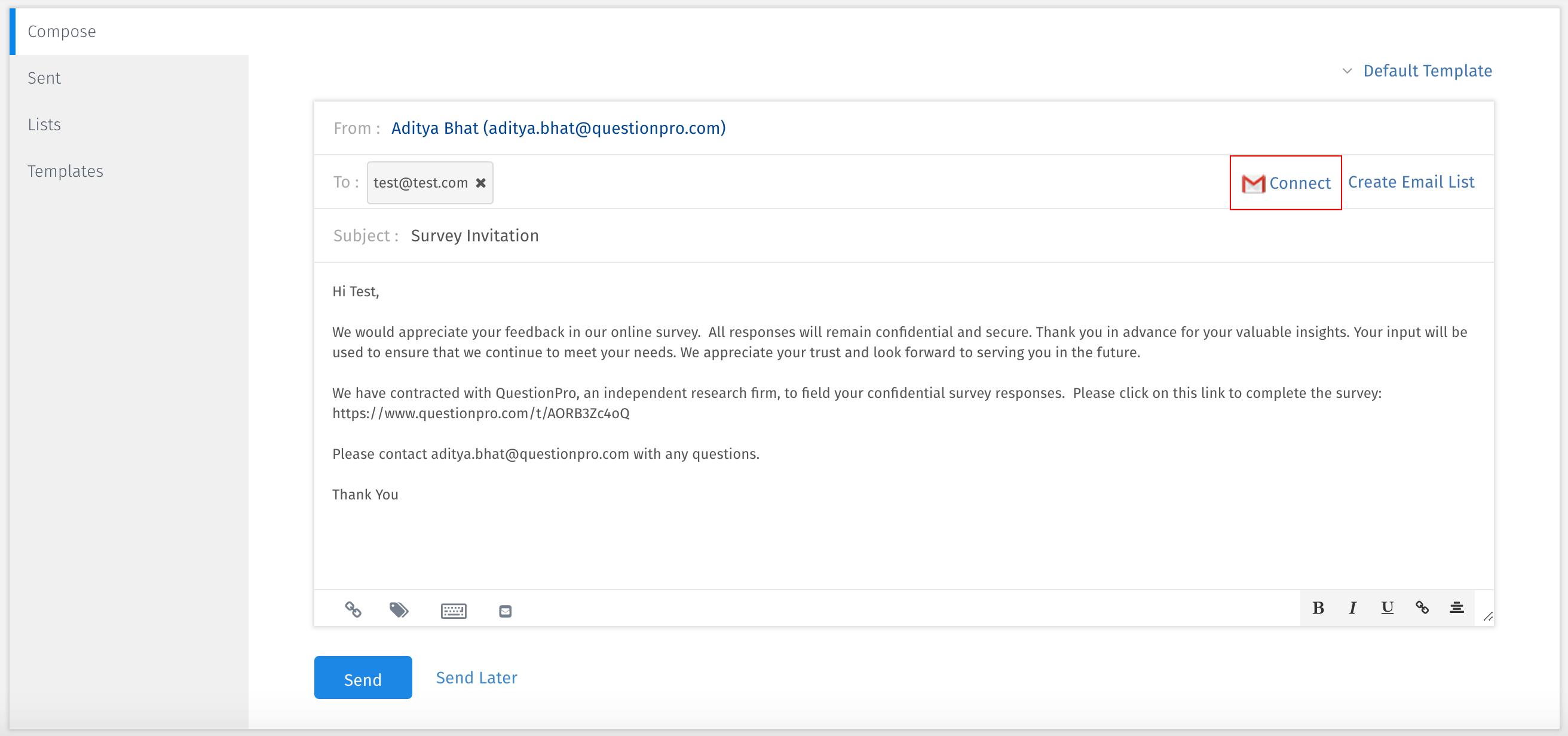Emailing the survey is one of the most efficient methods of data collection since the respondent often knows the sender by brand, name, or organization.
It's easy to create email survey templates customized to your organization with example surveys from QuestionPro. Reuse your customized templates to collect new responses as needed. This feature saves time, is cost-efficient, and is easy to administer. Email surveys are one of the preferred survey distribution methods as they have high response rates.
Example of an email survey
For example, a cat food company wants to launch itself in a new region. Researchers can conveniently target and survey cat owners belonging to that location and collect actionable research data. Researchers can survey potential customers on the type of product; it’s price, packaging, and appearance, to name a few. They gather reliable information quickly and plan the product's release according to the tastes and needs of the target market.

Uses of email surveys
Email surveys have been the go-to approach for survey data collection. Due to its convenience of use, it is widely used for various types of research. Here are the main instances where researchers make use of mobile surveys.
Customer surveys: Organizations conduct customer-oriented surveys like customer experience and customer satisfaction surveys. Most businesses already have a database of customer email addresses and thus find it convenient to send out customer surveys through emails.
Human resources surveys: Human resource managers must regularly monitor employee satisfaction, collect employee feedback, and assess business culture. The HR sends out anonymous surveys via email so employees can share their issues without the fear of being pointed out.
Marketing surveys: Marketing surveys are essential to marketeers for conducting comprehensive market research. Email surveys help marketeers collect feedback from a broad audience, thus helping the business make informed decisions.
Industry surveys: Hotels, retail outlets, health-care providers, travel, and tourism, catering to a wide range of customers. Usually, customers based out of multiple locations. Email surveys are the fastest, cheapest, and ideal channels for reaching out to these industries' customers.
Academic surveys: Educational institutions run student surveys, teacher surveys, and parent surveys to address the issues surrounding education. Student feedback is essential for the improvement of academic practices and courses. Again, email surveys are the most convenient way of reaching out to survey takers.
Types of email surveys
Surveys can be shared via email in two ways. One option allows respondents to take your survey in the body of the email. The other allows for longer surveys by having respondents click a link to access the survey in a web browser. Both methods are useful for collecting respondent answers fast so you can get the most out of your survey data.
Email inline surveys: The inline email survey is a simple but effective way of administering a survey. In this method, the respondent can take a survey without having to open a browser window because it is embedded in the body of the email. This method doesn't permit long-form surveys and is typically under five questions. The common question types used in an email-in-line survey are closed-ended questions like demographic questions, Net Promoter Score (NPS) questions, etc.
Email redirect surveys: The other method of sending surveys via email is an email redirect survey. The respondent is sent an email that contains a brief description of the survey. It also contains the survey link. Respondents can click on the link in the email and be redirected to the survey page. This method is more effective for longer surveys. It makes your survey easier to read and follow, encouraging respondents to complete the entire survey.
Advantages of email surveys
Sending surveys via emails is a common approach used by researchers, especially in market research. Let's look at the advantages it brings:
Better reach: A researcher can ideally reach out to anybody based out of any continent in the world, as emails are a standard channel of communication.
Saves cost: The cost of using emails for collecting market research insights is considerably low compared to the other collection methods like paper surveys and telephonic surveys.
Quantity of data: Because you can reach out to a vast number of people, the chances of you gathering more data is higher.
Saves time: An email can be scheduled and sent to thousands of potential respondents within a matter of minutes. This saves a lot of time, giving researchers the chance to spend time focusing on the other areas of the research.
Convenience: Respondents find it convenient to answer surveys online by accessing email redirect links. In some cases where the survey is lengthy, they can pause and continue the survey.
How to email your surveys?
Learn how to use this feature with our help file on email surveys.
 Survey software
Easy to use and accessible for everyone. Design, send and analyze online surveys.
Survey software
Easy to use and accessible for everyone. Design, send and analyze online surveys.
 Research Suite
A suite of enterprise-grade research tools for market research professionals.
Research Suite
A suite of enterprise-grade research tools for market research professionals.
 CX
Experiences change the world. Deliver the best with our CX management software.
CX
Experiences change the world. Deliver the best with our CX management software.
 Workforce
Create the best employee experience and act on real-time data from end to end.
Workforce
Create the best employee experience and act on real-time data from end to end.










